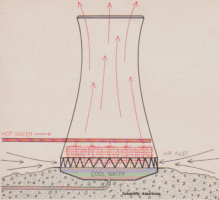 SKC Films Library SKC Films Library |
| SKC Films Library >> Technology >> > Mechanical Engineering and Machinery > Steam Engineering |
| Cooling Tower a device that dissipates industrial heat without dumping it directly into rivers or lakes In a "wet," natural-draft, counterflow tower, hot water from the plant is exposed to air moving up through the chimney-like tower. Heat is removed by evaporation and the cooled water is emptied into a waterway or recirculated through the plant. In cold areas water vapor discharged into the atmosphere can create a heavy fog. This Tennessee Valley Authority power plant on the Green River in Kentucky was, in 1969, the world's largest coal-fueled electric plant. Its three wet, natural-draft cooling towers, each 437 feet in height and 320 feet in diameter at ground level, had a capacity of 282,000 gallons a minute, which they could cool through a range of 27.5 degrees. A "dry" cooling tower (left) avoids evaporation. The hot water is channeled through tubing that is exposed to an air flow, and gives up its heat to the air without evaporating. In this mechanical-draft version air is moved through the tower by a fan. Dry towers are costly to operate. The two five-cell cooling towers seen below were built by the Marley Company for a chemical plant. They are wet, mechanical-draft towers of the cross-flow type: a fan in each stack draws air in through the louvers, across films of falling water and then up. The towers cool 120,000 gallons a minute through a 20-degree range. PRINT SOURCE |
| SKC Films Library >> Technology >> > Mechanical Engineering and Machinery > Steam
Engineering This page was last updated on May 18, 2017. |


